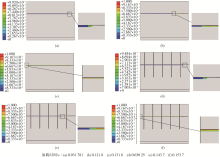 京公网安备11010802034965号
京ICP备13020181号-2
京公网安备11010802034965号
京ICP备13020181号-2
《中国塑料》编辑部 ©2008-2024 版权所有
地址:北京市海淀区阜成路11号 邮编:100048
编辑部:010-68985541 联系信箱:cp@plaschina.com.cn
广告部/发行部:010-68985253 本系统由北京玛格泰克科技发展有限公司设计开发

中国塑料 ›› 2021, Vol. 35 ›› Issue (3): 59-66.DOI: 10.19491/j.issn.1001-9278.2021.03.009
收稿日期:2020-11-02
出版日期:2021-03-26
发布日期:2021-03-22
基金资助:Received:2020-11-02
Online:2021-03-26
Published:2021-03-22
Contact:
ZHOU Guofa
E-mail:ndzgf@163.com
摘要:
针对金属基聚合物复合材料易诱发界面剥离损伤失效的共性问题,研究了通过多层复合组装注射成型,在聚合物复合层与粘接层界面形成短纤维桥接,实现复合界面强化。基于内聚力剥离损伤模型,构建了短纤维桥接强化界面剥离裂纹扩展断裂失效过程的模拟仿真技术,模拟建立了界面剥离裂纹快速失稳扩展断裂损伤失效临界载荷—桥接纤维特性—界面剥离断裂韧性(损伤启裂应力T0和临界应变能释放率Gc)的协同关联理论,诠释了短纤维桥接界面强化机理,提出了预防短纤维桥接强化界面诱发剥离裂纹快速失稳扩展失效的设计准则。结果表明,当桥接纤维密度为20根/mm2,可使其临界载荷增加55.9 %,临界载荷受控于桥接纤维密度、初始预裂纹面积、损伤启裂应力和临界应变能释放率,且与桥接纤维密度、损伤启裂应力和临界应变能释放率呈正关联关系,而与初始预裂纹面积呈负关联关系。
中图分类号:
计操, 周国发. 金属基聚合物复合材料短纤维桥接界面强化机理[J]. 中国塑料, 2021, 35(3): 59-66.
JI Cao, ZHOU Guofa. Interface Strengthening Mechanism of Short Fiber Bridging for Metal⁃Matrix Polymeric Composites[J]. China Plastics, 2021, 35(3): 59-66.
| 损伤启裂应力/MPa | 临界应变能释放率/J·m-2 | ||||
|---|---|---|---|---|---|
| TI0 | TII0 | TIII0 | GIC | GIIC | GIIIC |
| 31.9 | 31.9 | 31.9 | 800 | 800 | 800 |
| 损伤启裂应力/MPa | 临界应变能释放率/J·m-2 | ||||
|---|---|---|---|---|---|
| TI0 | TII0 | TIII0 | GIC | GIIC | GIIIC |
| 31.9 | 31.9 | 31.9 | 800 | 800 | 800 |
| 损伤启裂应力/MPa | 临界应变能释放率/J·m-2 | ||||
|---|---|---|---|---|---|
| TI0 | TII0 | TIII0 | GIC | GIIC | GIIIC |
| 56 | 56 | 56 | 1050 | 1050 | 1050 |
| 损伤启裂应力/MPa | 临界应变能释放率/J·m-2 | ||||
|---|---|---|---|---|---|
| TI0 | TII0 | TIII0 | GIC | GIIC | GIIIC |
| 56 | 56 | 56 | 1050 | 1050 | 1050 |


| 1 | HONKANEN M, HOIKKANEN M, VIPPOLA M, et al. Metal⁃Plastic Adhesion in Injection⁃Molded Hybri⁃ds[J]. Journal of Adhesion Science & Technology, 2009, 23(13⁃14):1 747⁃1 761. |
| 2 | TRUONG H T, LAGOUDAS D C, OCHOA O O, et al. Fracture Toughness of Fiber Metal Laminates: Carbon Nanotube Modified Ti⁃Polymer⁃Matrix Composite Interface [J]. Journal of Composite Materials, 2014, 48(22):2 697⁃2 710. |
| 3 | 廉英琦. 弱界面粘结的纤维增强金属基复合材料细观力学分析[D].南京:南京航空航天大学,2004. |
| 4 | BALDI A, AIROLDI A, CRESPI M, et al. Modelling Competitive Delamination and Debonding Phenome⁃na in Composite T⁃Joints[J]. Procedia Engineering, 2011,10:3 483⁃3 489. |
| 5 | 秦国锋. 温湿老化对车用CFRP/铝合金粘接接头静态失效的影响[D].长春:吉林大学,2018. |
| 6 | KHAN M A. Development of Rules for The Design of Adhesively Bonded Fibre⁃Reinforced Plastic Composite Joints in Aerospace Applications [D]. Guildford:University of Surrey,2018. |
| 7 | 赵玉萍. 复合材料中纤维/聚合物界面粘结失效机理研究[D].广州:暨南大学,2015. |
| 8 | RAWAL S P. Interface Structure in Graphite⁃Fiber⁃Reinforced Metal⁃Matrix Composites[J]. Surface & Interface Analysis, 2001, 31(7):692⁃700. |
| 9 | 李传习,柯璐,陈卓异,等.CFRP⁃钢界面粘结性能试验与数值模拟[J].复合材料学报,2018,35(12):3 534⁃3 546. |
| LI C X, KE L, CHEN Z Y, et al. Experimental Study and Numerical Simulation for Bond Behavior of Interface between CFRP and Steel[J].Acta Materiae Compositae Sinica,2018,35(12):3 534⁃3 546. | |
| 10 | 周储伟,王鑫伟,杨 卫,等.短纤维增强金属基复合材料的多重损伤分析[J].复合材料学报,2001(4):64⁃67. |
| ZHOU C W, WANG X W, YANG W, et al.Multiple Damage Analysis of Short Fiber Reinforcement Metal Matrix Composite[J].Acta Materiae Compositae Sinica, 2001(4):64⁃67. | |
| 11 | 段治锋. 金属基聚合物复合压力容器界面裂纹扩展及预防[D].南昌:南昌大学,2019. |
| 12 | LIU P F, PENG X Q, GUO Z Y,et al. Viscoelastic Bilinear Cohesive Model and Parameter Identification for Failure Analysis of Adhesive Composite Joints[J]. Composite Structures, 2019, 224:111016. |
| 13 | TAFAZZOLIMOGHADDAM B. Computational Mechanics of Fracture and Fatigue in Composite Laminate⁃s by Means of XFEM and CZM[D]. Sheffield:University of Sheffield,2017. |
| 14 | BABU J B. Predicting The Tatigue Behaviour of Matrices and Fibre⁃Composites Based upon Modified Epoxy Polymers[D]. London:Imperial College London,2012. |
| 15 | BUI Q V. A Modified Benzeggagh⁃Kenane Fracture Criterion for Mixed⁃mode Delamination[J]. Journal of Composite Materials, 2011, 45(4):389⁃413. |
| 16 | BRETT M A D O. Prediction of The Performance of Adhesively⁃Bonded Composite Joints[D]. London:Imperial College London,2012. |
| 17 | ALVAREZ FEITO D. Fracture Mechanics of Carbon Fiber Reinforced Plastics to Ti⁃Alloy Adhesive Joints[D]. London:Imperial College London,2013. |
| 18 | 王伟霞,顾轶卓,李 敏,等.单丝断裂双树脂法研究碳纤维/环氧树脂界面粘结性能[J].复合材料学报,2013, 30(4):1⁃6. |
| WANG W X,GU Y Z,LI M,et al.Characterization of Interfacial Bonding Property of Carbon Fiber/Epoxy Resin Using Single Fiber Fragmentation Test with Dual Matrix Composites[J].Acta Materiae Compositae Sinica, ,2013,30(4):1⁃6 |
| [1] | 冯冰涛, 王晓珂, 张信, 孙国华, 汪殿龙, 侯连龙, 马劲松. 连续碳纤维增强热塑性复合材料制备与应用研究进展[J]. 中国塑料, 2022, 36(7): 165-173. |
| [2] | 宋银宝, 杨建军, 李传敏. PDMS/SiC功能梯度复合材料性能与制造精度研究[J]. 中国塑料, 2022, 36(7): 30-36. |
| [3] | 杨小龙, 陈文静, 李永青, 闫晓堃, 王修磊, 谢鹏程, 马秀清. 导电型聚合物/石墨烯复合材料的研究进展[J]. 中国塑料, 2022, 36(6): 165-173. |
| [4] | 孙旗, 高兴, 崔雪梅, 连慧琴, 崔秀国, 汪晓东. 黑磷烯纳米阻燃剂研究进展[J]. 中国塑料, 2022, 36(5): 133-139. |
| [5] | 王轲, 龙春光. PE⁃UHMW/海泡石纤维复合材料的力学性能与摩擦学性能研究[J]. 中国塑料, 2022, 36(5): 19-23. |
| [6] | 陈胜, 梁颖超, 吴方娟, 方辉, 范新凤, 陈晖, 王永刚. 聚酰胺6/双向经编玻璃纤维复合材料的制备及其界面改性研究[J]. 中国塑料, 2022, 36(5): 24-28. |
| [7] | 田驰锋, 张洪申. 基于翅片式摩擦桶的车用聚合物粒子荷电及静电分离探索[J]. 中国塑料, 2022, 36(5): 75-80. |
| [8] | 刘文, 师文钊, 刘瑾姝, 陆少锋, 周红娟. 电致形状记忆复合材料研究进展[J]. 中国塑料, 2022, 36(4): 175-189. |
| [9] | 阮芳涛, 夏成龙, 张宝根, 曹叶, 刘志, 徐珍珍, 章劲草. 芳纶包覆碳纤维增强环氧树脂的轴向压缩性能研究[J]. 中国塑料, 2022, 36(4): 19-23. |
| [10] | 彭博, 肖运彬, 顾家宝, 陈梓钧, 唐雁煌, 朱刚, 徐焕翔. 聚合物/石墨烯复合材料制备与性能研究进展[J]. 中国塑料, 2022, 36(4): 190-197. |
| [11] | 宋立健, 张有忱, 左夏华, 张政和, 安瑛, 杨卫民, 谭晶, 程礼盛. 自组装单分子层调控界面热输运的研究进展[J]. 中国塑料, 2022, 36(4): 60-69. |
| [12] | 何毅, 赵广慧. 复合材料增强修复油气管道的研究进展[J]. 中国塑料, 2022, 36(4): 70-82. |
| [13] | 程曼芳, 白继峰, 王文清, 雷良才, 李海英, 韩向艳, 胡跃鑫. 基于超支化聚对氯甲基苯乙烯聚合离子液体共混体系的制备与表征[J]. 中国塑料, 2022, 36(3): 40-47. |
| [14] | 张庭, 金清平, 宋仕娥, 曹南南, 邓思远. 不同腐蚀环境下FRP筋耐久性与寿命预测研究进展[J]. 中国塑料, 2022, 36(3): 75-81. |
| [15] | 郝春波, 刘万胜, 赵欣麟, 王岩, 王月. 本体ABS用橡胶国产化替代分析及评价[J]. 中国塑料, 2022, 36(3): 89-95. |
| 阅读次数 | ||||||
|
全文 |
|
|||||
|
摘要 |
|
|||||
 京公网安备11010802034965号
京ICP备13020181号-2
京公网安备11010802034965号
京ICP备13020181号-2
